
Page 1 - Jewell Junction really
began as a railroad town. (Page
2) (Page 3)
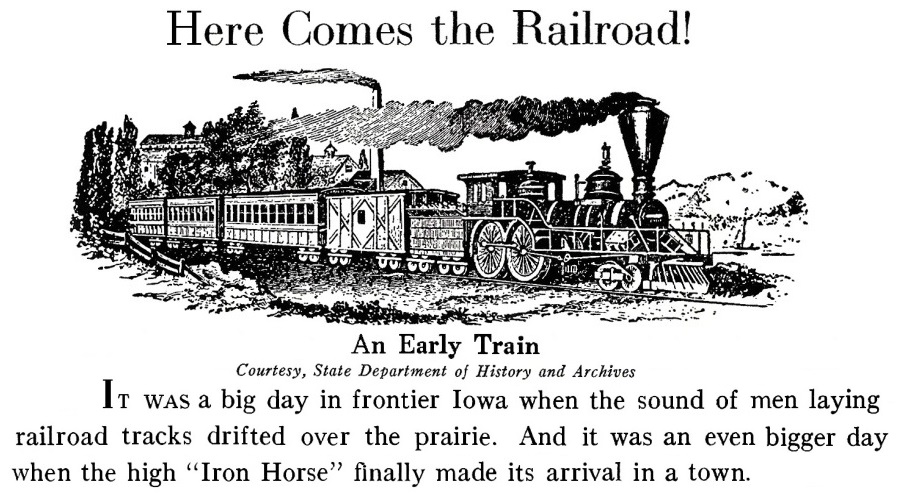
Because we now live in a world with many vehicles and
easy transporation, it not easy for younger people to comprehend how
Jewell and other nearby towns got started so quickly.
The important influence of railroads in forming towns in central Iowa
must be known to understand that Jewell began when
two railroad lines met.
The
earliest railroad effort in this north central Iowa area was in 1874, when
a narrow gauge (3 feet between rails) rail line had been completed from
Des Moines to Ames. First known as the Iowa and Minnesota,
and later as the Des Moines and Minnesota, the line came north to
meet the standard gauge (4 feet and 8 and one half inches between rails)
east-west rail line in Ames. Under the railroad president James
Callanan, a prominent Des Moines banker and real estate agent, the narrow
gauge was finally known as the Des Moines and Minneapolis Railroad
and was to be constructed for points north. For any settlement that
hoped for access to markets, a railroad became a necessity.
Railroad President Callanan started his railroad construction heading north.
Gilbert Station was started when the railroad arrived in 1878, promoted
by Hezakia Gilbert, who gave acres of land for the town. Early
in 1877, an election was held in Lafayette Township of Story County for
a five percent tax to pull the Des Moines and Minneapolis Railroad
to
Story City. Next in the railroad line going north was Randall,
formed as a community west of the South Skunk River, although the Randall
Postal location had since 1869, been located just east of the river.

About this Narrow Gauge Railroad
By the
spring of 1877, it was determined that if the people in four townships
in the southeast part Hamilton County (Ellsworth township, Lincoln Township,
Lyon and Scott) taxed themselves 5%, they might successfully use that money
to invite the railroad company to build north to this area, but the monies
would have been made available only if the railroad had actually been constructed
and operated to within a mile of those townships by December 1 of 1978.
This settlement was originally planned to have the name Lakin, for
an early pioneer of that part of the county. Since they discovered
that a post office with than name already existed, and knew that Mr. Callanan
was the primary investor of the railroad, they became convinced if they
would adopt "Callanan" to be the name of the community, the railroad might
be better tempted to come there. And the Des Moines &
Minnesota Railroad did indeed build their track there and did construct
a depot to provide rail service there. Some early maps like
this portion of a 1879 version (seen just
below) actually show this town as
Lakin.
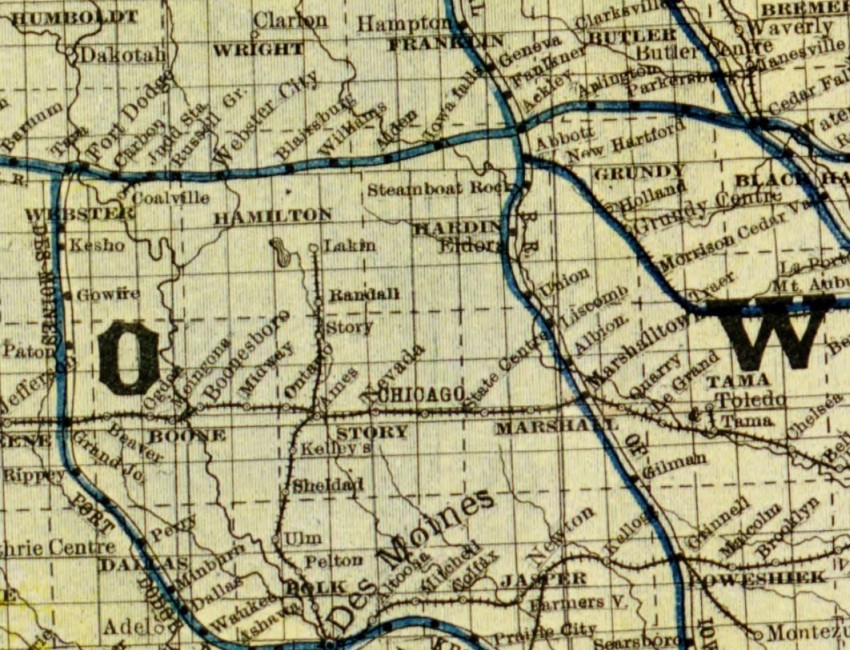
The town was laid out and was
actually platted with the name of Callanan on April 19, 1878.
That made Callanan the
first platted town in Southeast Hamilton County.

About Callanan, including the
map showing the platting of the town.
As the
railroad building fever reached a frenzy, the companies began to build
extensions throughout the state. The railroads wanted to capitalize
on their investments, so about every seven miles, a depot would be erected,
a siding laid down, and a town would materialize around that new connection
to the outside world. The railroads also constructed lines
solely to claim an area and to discourage incursion by competitors.
The Cedar Rapids and Missouri, now known as the Chicago and North
Western Railroad, did just that. Through a maze of interconnected
directorships, new railroad companies came into existance and just as quickly
disappeared.
One new line,
the Toledo and North Western Company of Tama, proposed building
a line north and west of Tama into the yet unconnected Iowa lands towards
Sioux City. On May 22, 1880, the Toledo and North Western
proposed building a line from Tama City to northwest Iowa and on into Minnesota
if they, too, could win tax incentives and real estate bargains along the
way. With remarkable fervor, the
Toledo and North Western
completed an 80.39 mile line from Toledo to Webster City and ran its first
passenger train between the two cities on December 6, 1880. When
the line was constructed, as it passed west, there developed new communities
of Hubbard, Radcliffe, the nearby town of Ellsworth, and constructed west
to David Jewell's enticement of offering land for depots, shops and yards.
The Jewell family household was just north of the coming east-west track,
so the new community was formed with the name Jewell Junction.
|
(This next article is from the Jewell Jubilee/Quasquicentennial
- June 7, 2006)
|
|
THE HISTORY OF JEWELL
Part III: The Railroad and Jewell: The earliest railroad effort in the
area was in 1874 when a narrow guage rail line (3 feet between the rails)
had been completed from Des Moines to Ames. First known as the Iowa
and Minnesota, then the Des Moines and Minnesota, the line met
the standard gauged (4' 8.5" between the rails) east-west line in Ames.
Under the presidency of James Callanan, a prominent Des Moines banker and
real estate agent, the narrow gauge was finally known as the Des Moines
and Minneapolis Railroad and was headed for points north. For
any settlement that hoped for access to markets, a railroad became a necessity.
Callanan started his railroad north.
Early in 1877, an election was held in Lafayette Township of Story County
for a five percent tax to pull the Des Moines and Minneapolis to
Story City. By the spring of 1877, the four southeast townships of
Hamilton County (Ellsworth, Lincoln, Lyon and Scott) did likewise, but
the monies would have been made available only if the railroad had actually
been constructed and operated to within a mile of those townships by December
1 of 1878. Work began on the narrow gauge line toward a point
that matched that location; a town was laid out on April 19, 1878 and humbly
named Callanan. But the future of Callanan lay not there, but
to two new towns about to make their debut.
As the railroad building fever reached a frenzy, the companies began to
build extensions throughout the state. The railroads wanted to capitalize
on the investments, so about every seven miles, a depot would be erected,
a siding laid down, and a town would materialize around the new hoped for
connection to the outside world. The railroads also built lines
solely to claim an area and to discourage incursion by competitors.
The Cedar Rapids and Missouri, now the Chicago and North Western
railroad,
did just that. Through a maze of interconnected directorships,
new railroad companies came into existence and just as quickly, disappeared.
One new line, the Toledo and North Western Company of Tama, proposed
building a line north and west of Tama into the yet unconnected Iowa lands
toward Sioux City. On May 22, 1880, the T&NW proposed
building a line from Tama City to northwest Iowa and on into Minnesota
if they, too, could win tax incentives and real estate bargains along the
way. With remarkable fervor, the
T&NW completed
an 80.39 mile line from Toledo to Webster City and ran its first passenger
train between the two cities on December 6, 1880. When the
line was constructed, it passed west through newly developed Hubbard, Radcliffe,
a new Ellsworth, and through David Jewell enticements of land for depots,
shops and yards. This rapid development in from the east brought
a stirring of activity in little towns at the end of the narrow gauge.
It was clear the new railroad missed the existing town to the southeast,
Callanan. Big money could await those who rose to take advantage
of this new town; John R. and Jane R. King of Callanan came to the area
for profit.
With money from his grain and saloon businesses in Callanan from 1878 until
1881, John R. King and his wife, Jane, bought up what property they believed
would be the site of the new town along the Toledo and North Western.
With his money, he persuaded the railroad to build the depot on his land
south of the tracks, applied for a post office to be in his part of town
south of the tracks, and put his lots south of the tracks up for sale.
To make more money, King platted his lots at 22 feet in width and 120 feet
in depth. King's Main Street shrank to 80 feet wide, rather
than maintain the 100 foot width in Jewell's town. From the
Jewell family account, there never was any animosity between the Jewells
and the Kings. The Kings made the money, but the name Jewell
stuck as the new entity was labeled Jewell's Junction or Jewell
Junction. Once the railroad had arrived and businesses
began to build on King's land, the original town began to move to the new
Main Street, todays' north-south street through Jewell. David
Jewell and his wife were buried in Evergreen Cemetery in Jewell.
King's legacy ramains through a scholarship fund for local students known
as the Jane R. King fund.
(View
the article.)
|
|
The Toledo & North
Western Railroad
1880
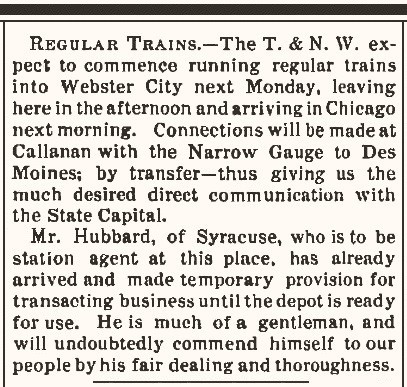
This news article published on December 1, 1880 in
the Webster City paper
The Hamilton Freeman contains this headline
and the following text:
|
|
REGULAR TRAINS
The Toledo & North
Western expects to commence running regular trains into Webster City next
Monday, leaving here in the afternoon and arriving in Chicago next morning.
Connections will be made at Callanan with the Narrow Gauge to Des Moines
by transfer -- thus giving us the much desired direct communication with
the State Capital. |
So now there was a new town called
Jewell or Jewell Junction
formed at this junction of the
Toledo
& North Western Railroad and the Des Moines & Minnesota
Railroad.
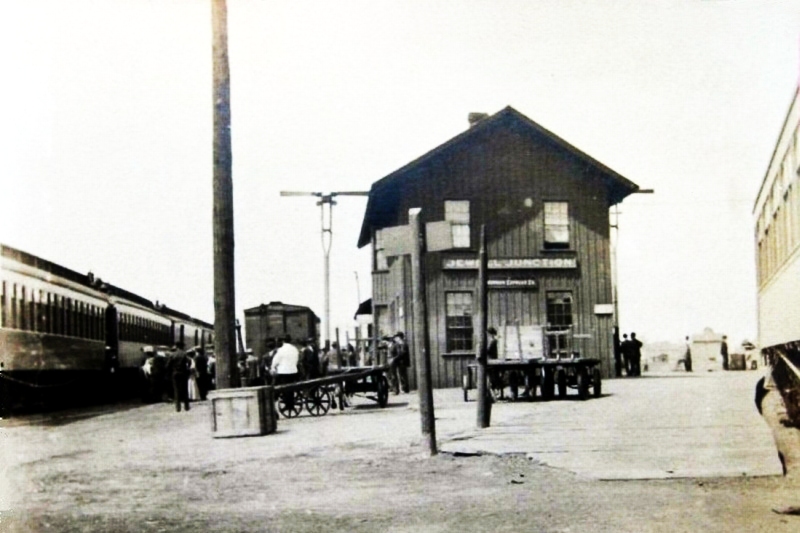
The original 1880 train station,
also known as the Depot, bore a sign with the name Jewell Junction.
Although the official name of
the town was Jewell, the railroad line called it Jewell Junction
as seen on the map and railway
schedule below and other photos seen on this page.

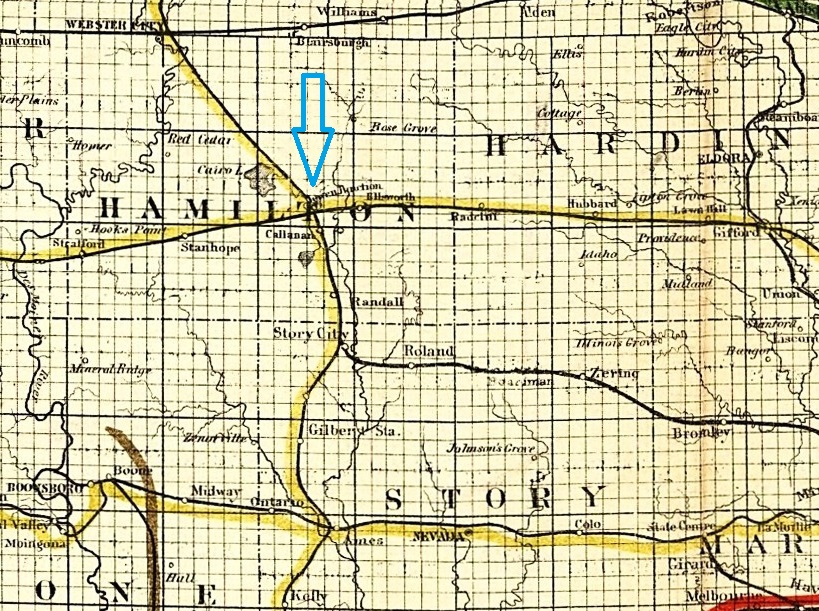
Jewell Junction, Callanan, and
Ellsworth can be seen on this portion of the 1881 Iowa Railroad Map seen
below.
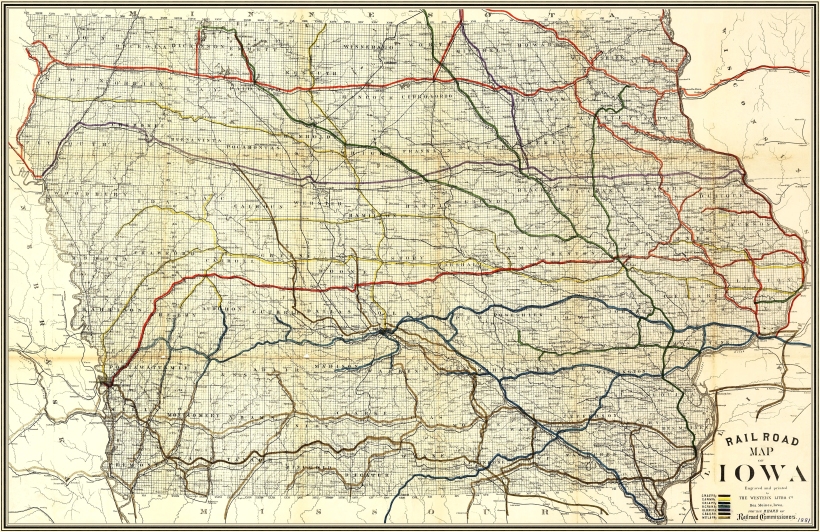
(You may click to enlarge this map.)
This
rapid development in from the east brought a stirring of activity in little
towns at the end of the narrow gauge. It was clear the new
railroad missed the existing town located to the southeast, Callanan.
Big money could await those who rose to take advantage of the possiblity
of a new town and now two area families would make that effort.
John R. and Jane R. King of Callanan came to this area for the profit.
With
money from his grain and saloon businesses in Callanan from 1878 until
1881, John and his wife Jane bought up what property they believed would
be the site of the new town along the Toledo and North Western.
With his money he persuaded the railroad to build a depot on his land south
of the tracks and applied for a post office to be in his part of town and
offered for sale lots south of the tracks. Once the railroad had
arrived and buisinesses began to build on King's land, the original town
began to move to the new Main Street, today's north-south street through
Jewell. David Jewell and his wife were eventually buried in
Evergreen Cemetery in Jewell. The King family legacy remains
through a scholarship fund for local students known as the Jane R. King
fund.
To make
more money, King platted his lots at 22 feet in width and 120 feet in depth.
King's Main Street shrank to 80 feet wide rather than maintain the 100
foot width in David Jewell's proposed town. From the Jewell family's
account, there never was any animosity between the Jewells and the Kings.
The Kings made the money, but the name of Jewell stuck, as the new entity
was labeled Jewell's Junction or Jewell Junction.
1881
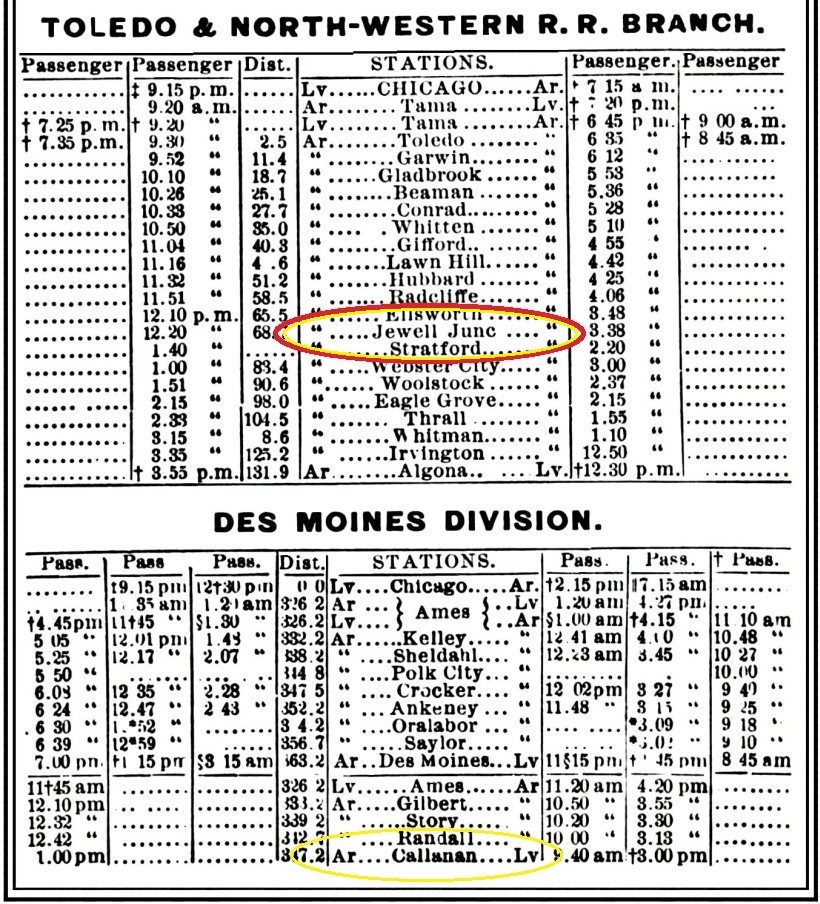
This 1881 schedule shows the
Toledo
& North Western Railroad company operated the narrow gauge railway
from Ames north to Callanan. This rail line was changed to
standard gauge width during 1882, so Callanan served as the end of the
line from roughly 1878-1882. After that change to standard gauge,
the Chicago & NorthWestern Railway company then operated the
line to Jewell and was well-known for generations.
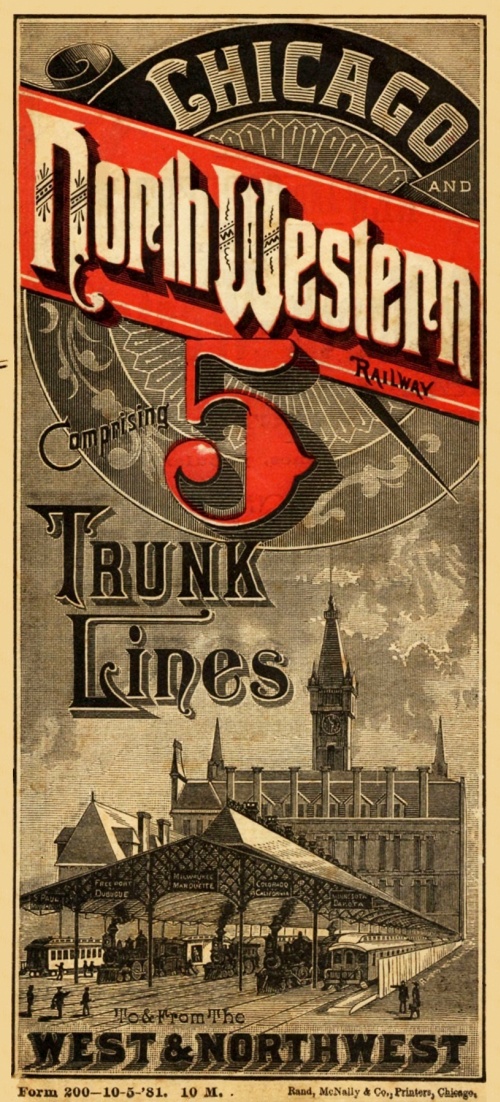
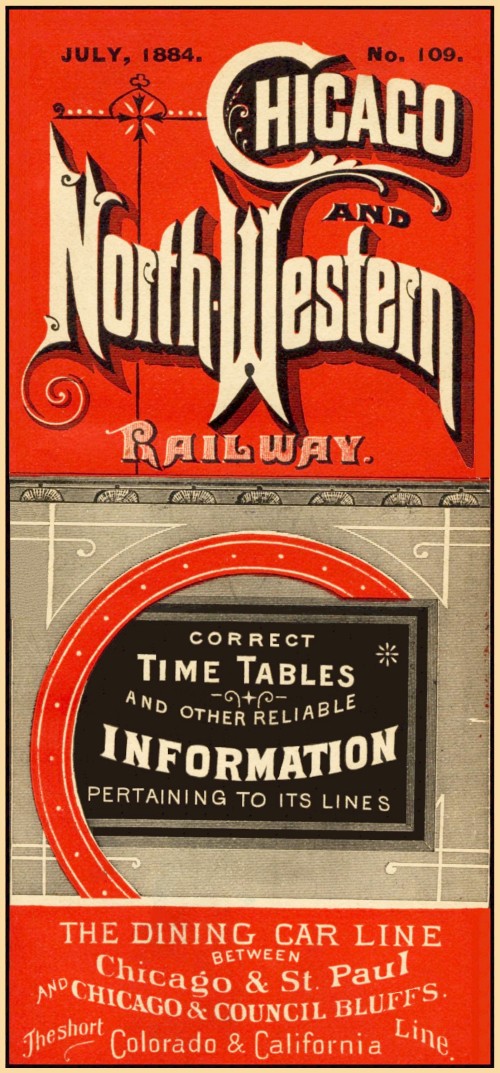
The Chicago
and NorthWestern Line was one of many railroad
companies in the late 1800s when Jewell Junction was thriving.
While the Chicago & North-Western Railway
advertisement seen above at left is from 1881
and the one seen above at right is from 1884,
This Chicago & North-Western Railway -
- - >
dates from 1885.
More about the
Railroads of America
in 1885,
including the railroad known
by the people of Jewell,
the Chicago & North-Western Railway

|

|
 |
<--- This news article
published April 18, 1895 on the front page of the Record News is
the Hamilton County Board of Supervisors report on both the amount
and the value of the railroad extent in each Hamilton County Township and
town.
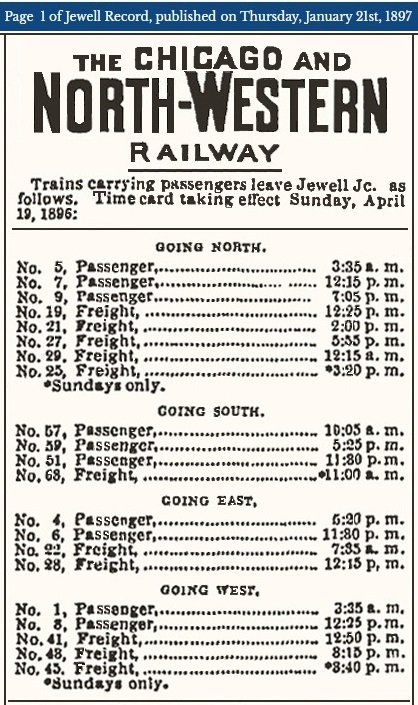
|
|
|
It is said that the first Chicago and NorthWestern station agent
in Jewell was named Hamlin (or Hammerle), followed by Thomas and Stidely.
Other station agents included Herbert Dwight Foval (1894-1911),
Joe Chever (1915), Burt Ford
(1916), Joe Kahl (1916- 1938), M. F. Schaferle (1940), Glen Deihl (1940-1963),
Jake Miller (1963-1967), and
Roger D. Sogard (1967-1976). |
|
|
|
1899 Locomotive Collision
in Jewell Junction
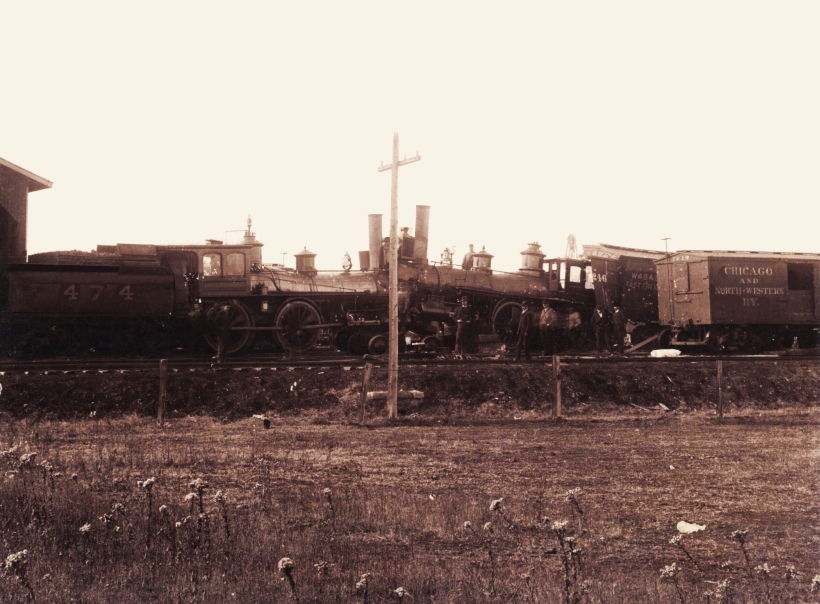
|
 |
Friday, June 30, 1899:
HEAD END COLLISION
Two Well-Loaded Freight Trains
Meet in the Yards Thursday Morning.
TWO ENGINES DEMOLISHED
NO ONE HURT.
About the hour of eight o'clock
yesterday morning a head end collision occurred just west of the C. &
N. W. depot at this place. It seems, from what the Record man
has observed, the engine No. 52 drawn by engineer Lowery, with a heavy
train was standing on the main line of track, evidently waiting for the
incoming of the double header from the east. Soon engines No.
356 and No. 450 with about 50 cars, came in sight, and were running at
a high speed. The men on 52 thought nothing of this, as the
supposition was that a slack in speed would be made by the time the water
tank was reached. However, the train kept up its speed, and
as a result collided with the train standing on the main line.
The engineers, firemen, and conductors all jumped, and thus succeeded in
escaping all injury. No. 52 which was standing still at the
time met, with very little disaster. Only the cow-catcher being
demolished. It was Nos. 356 and 450 which were completely wrecked.
The back engine telescoped partly over the first one and then took a tumble
to the north side. It was the worst wreck of the engines; their
being a good bell left the company will probably build a new engine around
it.
When a Record reporter reached
the scene of disaster the engines were piled up as if they intended to
"jump their job" and steam was escaping from breaks in the boiler of one
of the engines, and the scene was one of ruin and loss. The
wrecking crew at Eagle were immediately telegraphed for, and before an
hour and a half had passed, arrived and began clearing away the debris
and at the hour of six o'clock in the evening, there was nothing visible
of the wreck. No blame has been attached to anyone, as the
engineers on the double header claim the air brakes would not work, and
hence, the train could not stop. The train on the main line
was entitles to the track, and therefore no blame can be attached to the
parties conducting it. It was a serious wreck for the company
and the aggregate loss will be nearly $25,000. It was a very
lucky accident inasmuch as no one was in the least injured.
|
|
|
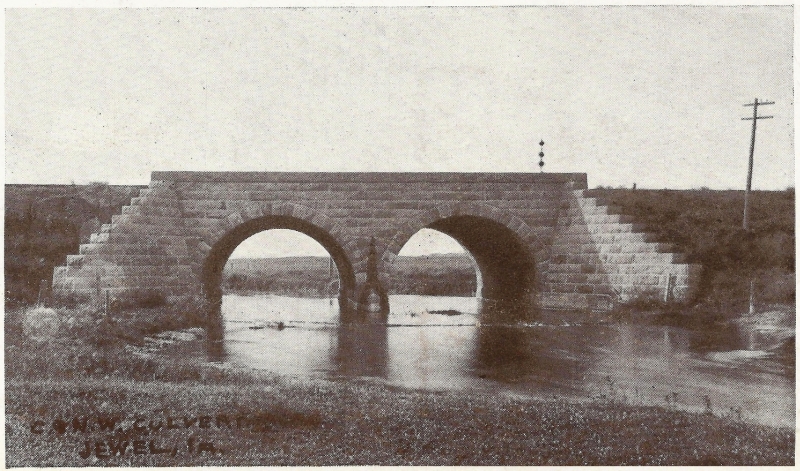
The twin arch stone bridge which was constructed in
1902 to allow the railroad tracks to cross the drainage creek
from Lake Cairo, also known as Mud Lake.
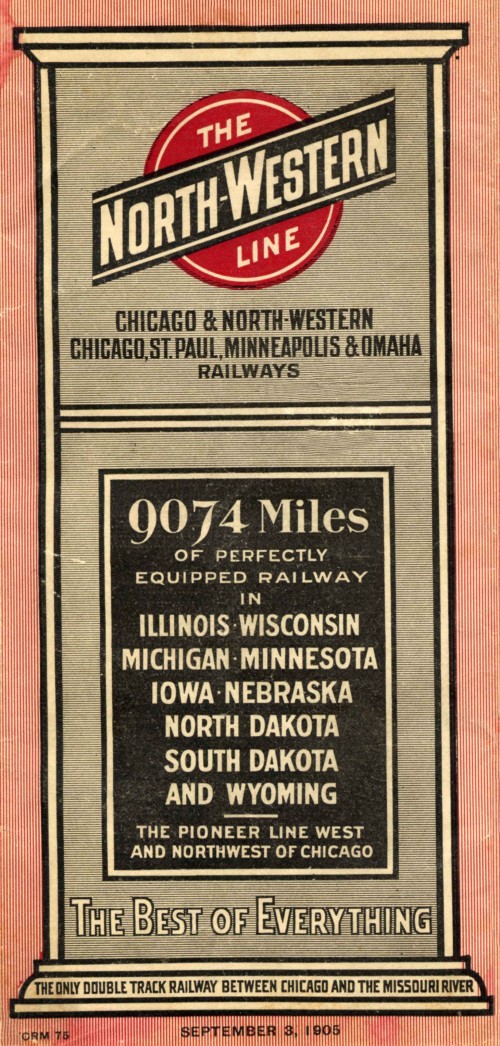
1908 Map of Chicago & North-Western Railroad
Company railways
(You may click to view a larger version of this 1908 Map)

An enlargement of the Iowa portion of the above map is seen next:

While showing the railroad lines, these maps do not show the midwest
or the state of Iowa to an exact scale.
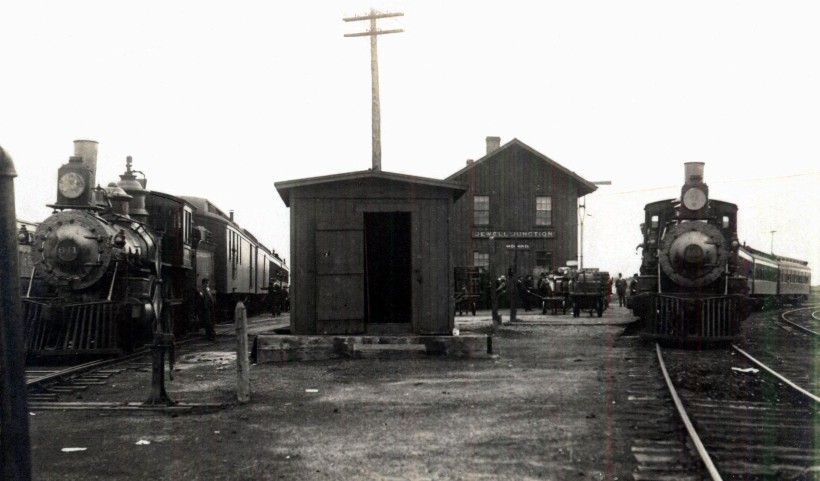
The photos seen just above and
below this text show the Jewell Depot in 1908,
just months before the Jewell
train station was lost to fire.
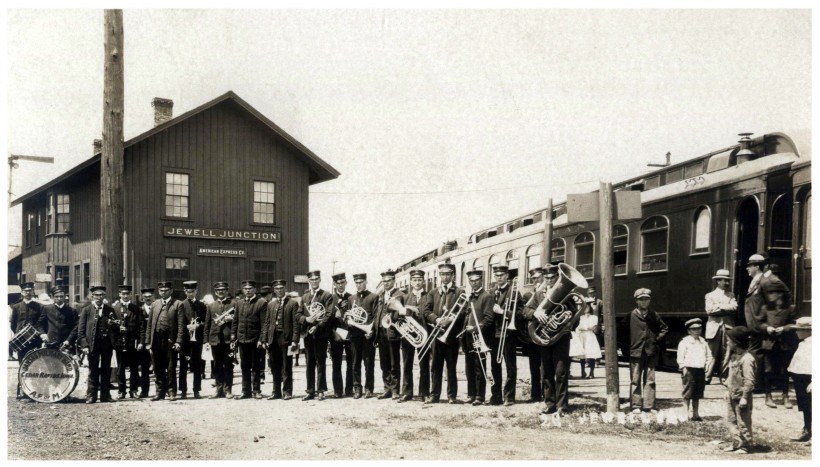
Go to our "Stories"
page to learn more about the above photo.

|
|
- Click this portion to see the entire news article. -
|
This news article was published on
October 8, 1908:
|

|
DEPOT BURNED LAST FRIDAY
Friday
afternoon, October 2nd, is a date that will be remembered in Jewell.
On that date the depot that was erected when the C. &. N. W. Ry.
first built into Jewell some twenty-seven or eight years ago, burned to
the ground. The fire had gained great headway four o'clock
and there was no chance to save even a part of the building from the flames.
Everything was dry as kindle and but for the gale that blowed from the
south it is only probable that the fire loss would have extended south
along the business street indefinitely. As it was even against
the wind the men fighting the flames had hard work to prevent the Kleaveland
lumber yard from igniting. A barn owned by Peter Mortenson
and located 60 or 70 rods north of the depot was ignited by flying brands
and with its contents burned to the ground.
The
fire originated doubtless from a spark from a passing engine and began
burning beneath the high wooden platform used in unloading freight from
cars. The fire burned along beneath the platform the full length
of the long platform and was not discovered until the whole was in flames.
When it broke out and was discovered it was merely a matter of minutes
until the entire wooden structure was a mass of flames. The
depot men succeeded in saving the tickets and bills and records of the
freight, passenger and express departments and a few telegraph instruments
from the office, the end of the depot furtherest removed from the place
where the blaze originated. Not a thing was saved from the
baggage and freight and express rooms and even a truck load of seven sample
trunks belonging to a representative of Marshall Field & Co. and standing
near the depot was burned to the ground. The fire burned rapidly
and it was not long until the depot was burned to the ground, including
most of the platforms about it.
Without
the loss of any time the railroad men cut three dispatchers lines into
the pump house and established the instruments there and business along
the line was interrupted for but a marvelously short time.
Freight cars were pulled up to use for freight and baggage rooms, a passenger
car was used for a passenger waiting room, and the room south of Kleaveland's
lumber office was secured for a ticket office. Men were early
on the ground clearing away the ruins. The thing seemed almost
impossible, but within forty-eight hours after the fire broke out the ruins
were cleared away, a platform of cinders and cruched stone was put in,
and work was nearly completed upon a temporary depot. Everything
was moving in formal fashion by Monday noon and the depot men were occupying
their new quarters.
The
thing that is now occupying the minds of everyone is what will the railroad
company do about a new depot. Everyone thinks Jewell should
have a fine new structure of brick with brick or cement walks and platforms,
and the general opinion is that if built on the old site, the freight depot
should be a separate building located somewhere else, perhaps farther west.
What will be done nobody knows. But conversation with those
in authority appears to give a good deal of satisfaction to everyone concerned.
The
Northwestern is not in the habit of being niggardly in its building operations
and works with an eye upon the future. As long as the old building
stood it served for present needs after a fashion. But confronted
with the necessity for rebuilding, the chances are that Jewell will be
given a splendid and modern structure. Supt. Smith of this
division speaks very encouragingly along this line. He can
give no positive information for he is not possessed of any.
But he seems to favor giving Jewell an up-to-date structure and the wishes
of the men on the ground will of course have its share of effect.
From the Chicago offices will come definite information when the matter
is disposed of. And there is not apt to be much delay in the
matter, only long enough to make a careful study of the situation.
What really will be done here will be significant of the road's future
policy regarding the town. It might be within the possibilities
to build with the idea of making Jewell a more important junction point
than it new is. Whatever is done will be done with no greater
delay than necessary and Jewell will undoubtedly ..see work under way on
a new and permanent depot early this fall. |
| |
|
|
This following news article was published
in the Freeman-Tribune on October 15, 1908:
|
|
The people of Jewell are not mourning the loss of the Chicago &
Northwestern depot to any very great extent. They now expect
the railroad company to erect a station that will be a credit, rather than
a disgrace, to the town. And Jewell is one of the most important
points on the Northwestern line in this state, so far as passenger
service is concerned, and the company ought to build a depot in keeping
with this fact. |
|
|
|
This news article was published in
The Jewell Record on October 22, 1908:
|
|
Mr. Peter Mortenson has requested the Record to express through its columns
his most hearty and sincere thanks to the kind people of Jewell for their
neighborly and friendly action in raising a purse to aid him in erecting
a new barn recently to take the place of the one burned in the depot fire.
Mr. Mortenson was not aware that the purse was being raised until Mr. Ole
Hanson, who circulated the paper, brought him the money $43.75.
Such courtesy and kindness is certainly greatly appreciated by Mr. Mortenson. |
|
|
|
This news article was published in
The Jewell Record on October 29, 1908;
|
|
NEW DEPOT SITUATION
There really are no new developments
in the situation regarding the new depot to be built at Jewell by
the Northwestern road. There have been rumors and reports in
plenty along the line of the probability of work beginning at once, and
there have been stories about $25,000 plans that have been drawn up and
later changed. So far as this paper has been able to ascertain
to date from the officials, there is really nothing that has as yet been
definitely decided upon.
There is one thing that is
very certain. There will be no work done on a new depot until
next spring. If final plans are determined upon soon opening
work in the way of excavating putting in foundations may be started, but
that even is very unlikely. Arrangements have already been
made for putting the temporary depot in shape for use during the winter.
The building is to be doubled and ceiled up inside so as to be warmer for
use throughout the winter. It can be confidently predicted
that the present temporary structure will serve this winter and that in
the spring the work will be started upon a permanent depot that will be
a credit alike to the town and to the road. |
|
|
|
This news article was published in
The Jewell Record on December 30, 1908:
|
|
The C. & N. W. Ry. is building an addition to the depot in the way
of a baggage room to the east of the waiting room in the temporary structure
that is doing service this winter. |
|
|
|
This next news article was published
in The Jewell Record on April 1, 1909:
|
|
The first signs of work towards Jewell's new depot began Monday when a
force of men started erecting a temporary platform for unloading freight.
The temporary platform is just west of main street along the main line
Sioux City track. |
|
|
|
This news sentence was published in
The Jewell Record on April 15, 1909:
|
|
S. A. Hoon has a big force of men at work excavating for the new depot. |
|
|
|
This news article was published in
The Jewell Record on March 18, 1909:
|
|
CONTRACT LET FOR NEW DEPOT
The contract has been given
by the C. & N. W. Ry. for the promised new depot at Jewell,
and the certainty of a new depot is now a real and tangible thing.
J. J. Jobat, of Peoria, Ill. has the contract for the structure and was
on the ground the first of this week looking over the local situation.
Jewell will have the pleasure of seeing actual construction work under
way the first of April.
In round figures about $20,000
will be spent in Jewell. This will include the new depot, freight
depot, and rearrangement of the yard tracks. The new depot
will be a standard frame structure with a slate roof, 104 feet long and
20 feet wide for the main structure, with a 5 foot extension south for
the length of the office a a longer wing north from the office to accomodate
toilet and rest rooms for men and women. There will be a ladies'
waiting room east of the office and men's waiting room west of the office,
with connecting passage north of the office, and toilet rooms opening from
this passage to the north. Baggage and express rooms will be
in the west end of the building. On the north of the structure
will be the platform built of brick, and the tracks will be rearranged
so that all passenger trains will come in north of the new depot.
The building, extending east and west, will be located about on the site
of the burned depot, just south and closely adjacent to the present temporary
structure. The west bound passenger tracks will run in north of the
depot and further west will swing back south to the main line Sioux City
tracks. The only trackage south of the depot will be the main
line Sioux City tracks, all freight yard tracks for switching south of
the depot being west of Main street and the freight depot west of Main
street.
By the new arrangement passengers
at the depot will not have to cross freight switch tracks to reach the
depot, nor to go from one train to another when transferring.
Nor will freight and passenger train service interfere with each other.
The new arrangement will therefore not only be more convenient for the
rail road, but will be by far more convenient and safer for the traveling
public. The building while not of brick as had been hoped,
will be, it is promised, not a plain barn-like affair, but will be a tasty
and handsome structure. With the new track arrangement, double
tracks east to the switch, new well and a new stand pipe, brick platform
and the new depot, the local officials are all sanguine that the people
of Jewell and the traveling public will be well satisfied with what the
company will do at Jewell.
Work will begin promptly.
April first will mark the beginning of operations when excavation and building
will be begun. The contractors are giving local dealers and
workmen their chance on the building. So far as possible cement
and lumber, etc. will be bought of local dealers. Local contractors
may have an opportunity to do the excavating. In this regard
the contractor, Mr. Jobst, appears to be emiently fair and generous in
dealing with the local people. |
| |
|
|
This news article was published in
The Jewell Record on May 6, 1909:
|
| The
workmen on the new depot are pushing the work rapidly and the building
is now entirely enclosed. The interior work and plumbing and
putting on the tile roof will probably require most of this month and it
is anticipated that the building will be ready for occupancy by June 1st.
The men who are grading for the new arrangement of tracks and those who
are digging drain ditches are pushing their work rapidly and will probably
have the yards in readiness in a month. It is expected that
arrangements will be made to continue the well that is being dug six or
eight hundred feet further if necessary to get sufficient water.
The work is now stopped temorarily at about a depth of 375 feet. |
|
|
|
This news article was published in
The Jewell Record on May 20, 1909:
|
|
EXTRA TRAINS GALORE LAST SATURDAY
Last Saturday this town of
Jewell was a great railroad center so far as the number of passenger trains
run through here by the Northwestern was concerned.
In addition to the usual good passenger service Jewell had nineteen extra
trains between midnight Friday night and midnight Saturday night.
The speculation as to the cause of it all was various, running all the
way from a guess that the Northwestern was running specials here
to show the public our new depot, to guesses to the effect that a mistaken
idea was abroad that the Jewell-Ellsworth baseball game was to be played
Saturday instead of Monday, the the specials were run to accommodate the
fans from all over the universe and Missouri that wanted to see the game.
The cause of the extra trains
was the fact that a bridge at a Quarry just east of Marshalltown was washed
out by the heavy floods of Friday southeast of here. While
the bridge was being rebuilt all main line passenger trains of the Northwestern
line were run through Jewell. West bound trains left the main
line at Tama coming to Jewell and down to Ames, east bound main line trains
came up from Ames and east from Jewell to Tama. The result as that
Jewell for a day had an average of about one passenger train an hour, counting
the regular train. The main line through fast trains made quite
a big play for Jewell. |
|
|
|
This news article was published in
The Jewell Record on June 10, 1909:
|
Friday the folks down at the depot moved into their new headquarters and
now traveling public and railroad employees alike have most excellent accomodations.
Work is not completed by any means in the
rearrangement of tracks and freight depot, but enough
is done so the public now appreciates the excellence of the new deal here. |
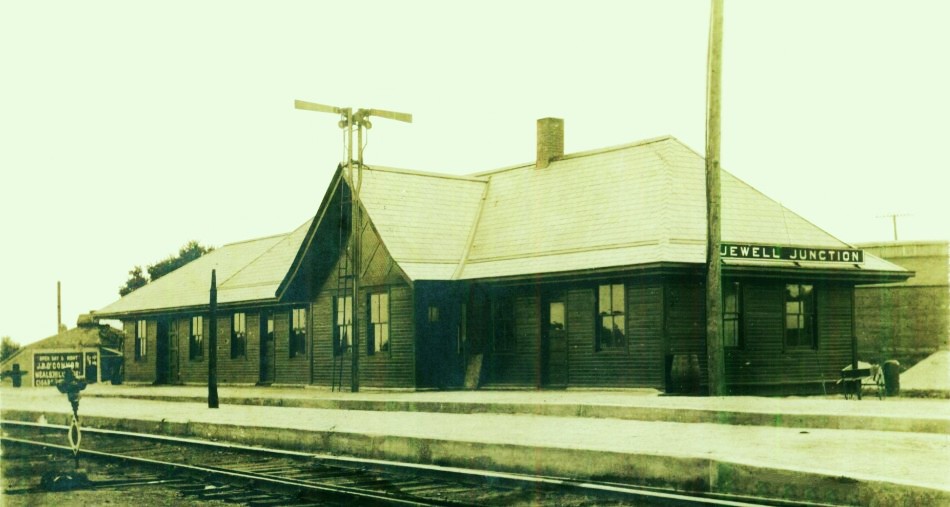
The building seen at left of
this 1909 image was the Beanery, located east of the Jewell Depot.

J. B. O'Conner was the first
operator of The Beanery, located by the railroad tracks to serve
food for all trains.
The beanery personel would fix
sandwiches and lunches. They would meet the train and sell
sandwiches on the train.
In 1922 Mr. Albert Guhl bought
the small Depot Lunch Counter, then known by many as The Beanery,
fron T. B. O'Conner.
1909 Postcard Photo looking South towards and over
the depot

This photo taken from the top
of the second water tower north of the tracks, was the view looking Southwest
at Jewell over the new depot. A passenger train is on track one,
and freight cars in front are also on the Sioux City freight tracks behind
the depot. The building marked as Lunch Room sat on
the southwest corner of Carmichael and Main Street with a Livery and Feed
Store seen at right.
1912
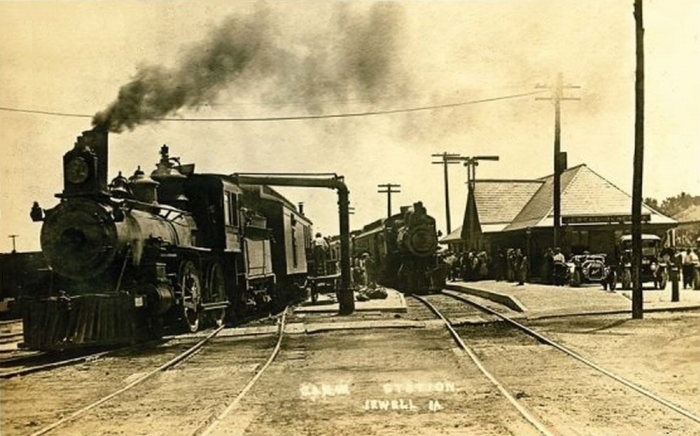
This photo which looks East from the Highway 69 Main
Street is from a 1912 postcard which shows the train at left on the track
which allowed it to head north beyond Kamrar to Eagle Grove after receiving
water from the standpipe. The train seen in the center is waiting
its turn to move forward and receive water before heading west towards
Wall Lake and Sioux City.

|
Published in the Jewell Record
on November 7, 1912.
|

1912 image of a railroad scene in rural Iowa
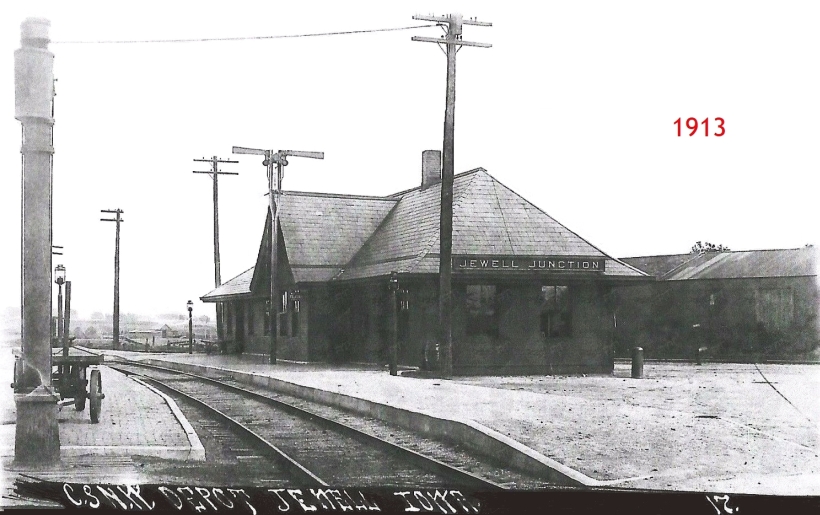
This 1913 postcard image also looks East from the highway
main street.

This next early map shows the
railroads in Hamilton County
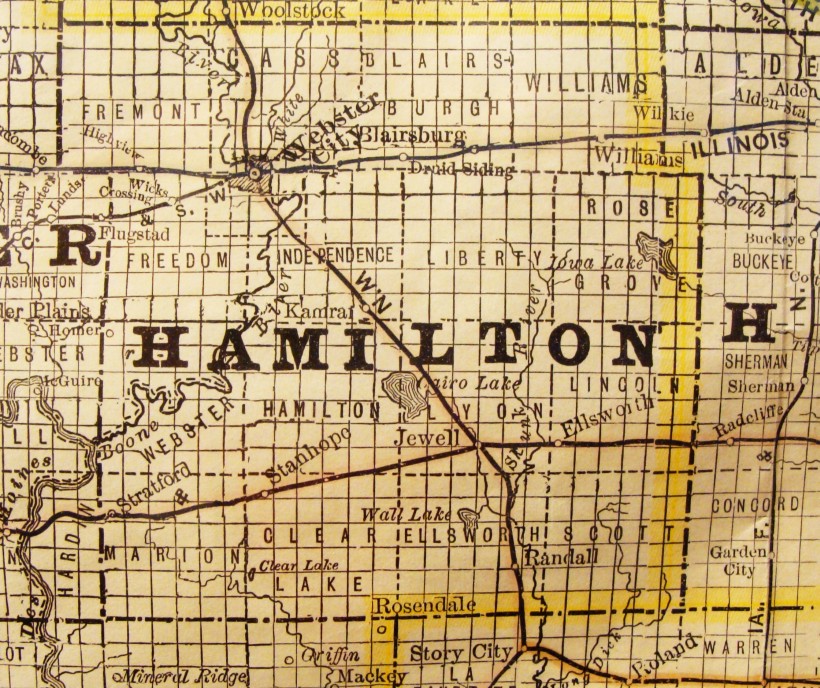
Don't be confused by the names (all caps) of Hamilton
County townships on this map.
(Learn more . . . . about
townships.)
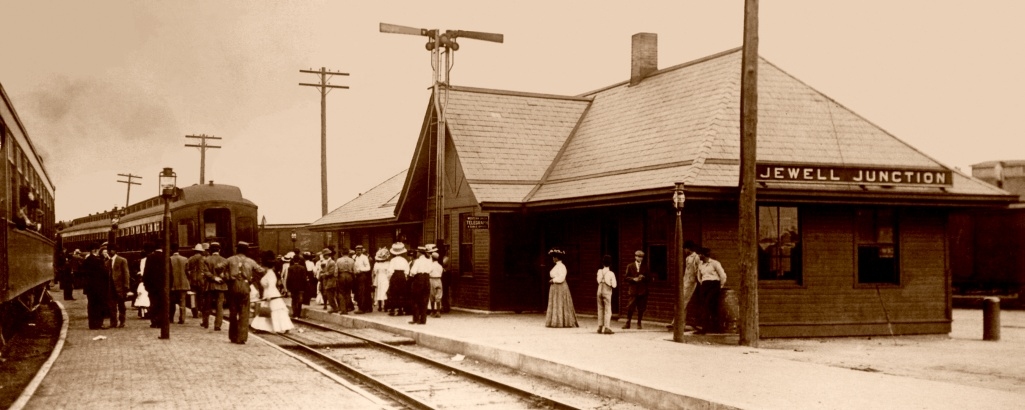
The Jewell Depot was often a
very busy place with the people going north to Eagle Grove, south to Ames
and Des Moines,
as well as east towards Ellsworth
or Hubbard and west to Stanhope, Stratford and Dayton.

Many small towns like Randall and Kamrar (and
Gilbert Station) are not located on state highways,
but those towns prospered because they were on the
railway line.
And in reflecting how things have changed in the last
hundred years, we notice that the two roads used today
to connect Jewell and Stanhope are not very
direct, but the old railroad line was as direct as is possible.
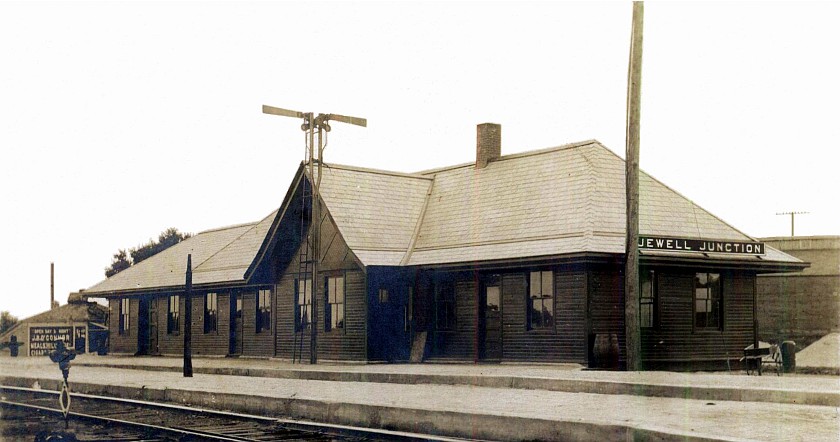
This image of the Jewell Depot
looks southeast from Main Street.

is found on Page 2 of Railroads in Jewell.
-






































